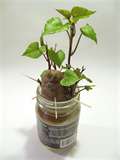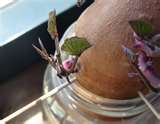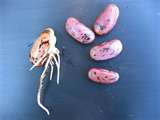February Activities
Soon the bulbs that are planted out in your garden will be blooming. However, you can have these same plants blooming in your home earlier……

Visit a florist or supermarket who has a floral department. Many have little pots of bulbs this time of year. Place the pots on a sunny windowsill or table and water the bulb every few days Watch them grow and flower. Draw the plants in their stages of growth in your Nature Journal. You can also buy loose bulbs from a garden center and plant them yourself in soil or stone in a flower pot or shallow bowl. Follow the directions given by the garden center.
Bulbs, Tubers and Corms are underground, reproductive stems that store food for next year’s plants. In bulbs like tulips or onions, the food is stored in fleshy scales surrounding a short, thin stem. In tubers like potatoes and carrots, the food is stored in the stem itself, which is thickened and spongy. A corm is a short, solid, underground stem much like a tuber it is often consumed with a bulb. Crocuses and gladiola are corms.


You can set a sweet potato supported by toothpicks in a jar of water, and it will soon grow roots and leaves. You can also do the same with a carrot or a turnip. draw the various stages of growth in your Nature Journal.
Seeds contain the new plant are produced within the flower of the parent plant. Each seed grows only one plant. Beans are seeds.
Soak some dried beans in water overnight. Get a quart size jar with a wide mouth and fill it 1/2 inch or so of water. Take a double layer of dampened paper towel and line the inside of the jar with it. Place your soaked beans midway up the jar between the paper towel and the glass. After several days you will see the beans sprout. Be sure to record and draw your findings in your Nature Journal.

